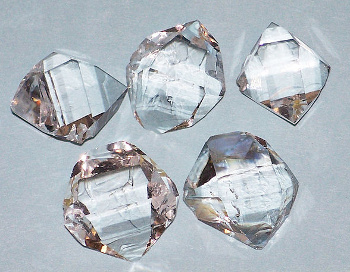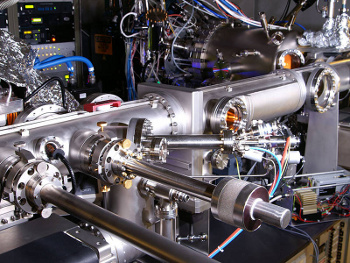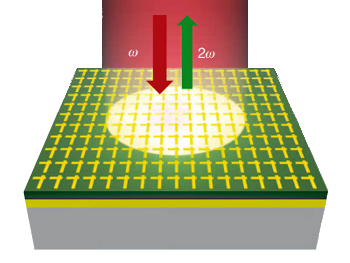Thin Optical Doubler
July 23, 2014
Harmonic generation is an undesirable feature of some
electronic systems, such as
audio amplifiers, but it's useful in other cases. In the early days of
FM radio,
frequency control of
transmitters at their 100
MHz frequency was difficult.
Quartz crystals, at that time the preeminent means of deriving a precise frequency, only had
fundamental frequencies up to about 20 MHz. The solution was to force the crystal to
resonate at a harmonic of its fundamental frequency.
If you need to operate at 90 MHz, the fifth harmonic of a crystal with a fundamental frequency of 18 MHz will get you there. The situation is somewhat more complicated, since a crystal's harmonics are not exact multiples of the fundamental, so the fundamental frequency is adjusted to compensate. Only
odd harmonics can be excited, since only these
wavelengths satisfy
reflection symmetry at the crystal surface. Today,
atomic clocks are substituting for many crystal oscillators.[1]

Synthetic Berlinite (AlPO4) crystals grown by hydrothermal synthesis.
This material is isostructural with quartz, and it has similar piezoelectric properties.
(Wikimedia Commons photo by the author.)
The harmonics of quartz crystals are generated mechanically by the crystals themselves, but there are ways to generate harmonics electronically through use of
nonlinear devices. These nonlinear devices can be
diodes or specially
biased transistors, and one common use is in
frequency doublers. Frequency doublers are useful components in
radio frequency systems, allowing you to convert a stable, lower frequency into a stable signal at twice the frequency. A
bandpass filter allows selection of the doubled frequency and rejection of the fundamental and other harmonics.
As I wrote in an
earlier article (Second Harmonic Light Generation, September 30, 2011), this same frequency doubling trick can be done
optically in media having an
optical non-linearity. Nonlinear optical
crystals will generate higher
frequency (lower
wavelength)
harmonics of an intense light source, typically the output of a
high-power laser.
These non-linear optical effects only occur at high light
intensities, where the
electric field component of the light is correspondingly high. That's why the first demonstration of
optical frequency doubling, in 1961, was after the
invention of the laser.[2] That was a doubling of the 694
nanometer (nm) emission of a
ruby laser to 347 nm by a quartz crystal. A year later, optical frequency doubling was demonstrated in
calcite.[3]
Quite a number of
efficient optical doubling crystals have been found. These include
lithium niobate (LiNbO
3),
lithium tantalate (LiTaO
3),
potassium titanyl phosphate (KTP, KTiOPO
4),
lithium triborate (LBO, LiB
3O
5) and
β-barium borate (BBO, β-BaB
2O
4). However, these will only work when excited by intense laser light, and a long
optical path length is generally required.
Now, a team of
electrical engineers and
physicists from the
University of Texas at Austin (Austin, Texas) and the
Technische Universität München (Garching, Germany) have advanced the
technology of nonlinear optical materials with the result that even the low intensity light from a
laser pointer could be doubled.[4-6]
They used the nonlinear response of
intersubband electron transitions in
multi-quantum-well semiconductor heterostructures. To do this, they needed to engineer a
metamaterial that could use these modes, which are limited to light with electric field
polarized normal to the semiconductor layers.[4] They were able to produce a nonlinear
mirror of 400 nm thickness with a nonlinear
electric susceptibility greater than 5 x 10
4 picometers per
volt to frequency double normally-incident
infrared light.[4]
The
research team calls their device a "nonlinear mirror." This 400 nm thick mirror is about a million times more efficient as an optical frequency doubler on a thickness basis than conventional crystal doublers.[5-6] The heterostructure is about a hundred alternating
nanoscale layers of
indium gallium arsenide and
aluminum indium arsenide, created using
molecular beam epitaxy (see photo). There's a
gold electrode at the bottom, and a pattern of gold
nanostructures on top. The dimensions of the heterostructure and electrode pattern determine the operating frequency of the device.[5-6] The
experimental device converts 8000 nm light to 4000 nm.[6]

Oh, shiny!
Technische Universität München molecular beam epitaxy (MBE) system.
From my Tom Swift days, I've enjoyed seeing diagrams and photos of scientific instruments.
(Technische Universitaet Muenchen image.)[5)]
Aside from the high conversion efficiency, the nonlinear mirrors are not subject to an important criterion for transmission optical frequency doublers; namely, the need to
match the phase velocities of the primary and doubled waves.[5] Although this device is not quite capable of operation at
visible light frequencies, it can be designed to work from
near-infrared to
terahertz frequencies. It will also function as a sum- and difference-frequency generation medium, and also as a means for
four-wave mixing.[5]
Among the applications for such a device is the ability to detect
terahertz radiation by mixing with an optical
local oscillator to put it into the range of a more sensitive
detector. The terahertz
spectrum is of interest for many sensing and
imaging applications, since such
radiation is harmless to
biological tissue, unlike
X-rays.[5] Says study participant,
Andrea Alù, an
associate professor at the University of Texas at Austin,
"This work opens a new paradigm in nonlinear optics by exploiting the unique combination of exotic wave interaction in metamaterials and of quantum engineering in semiconductors."[6]
The research was funded by the
National Science Foundation, the
US Air Force Office of Scientific Research, the
US Office of Naval Research, and the
German Research Foundation.[5-6]

Representation of optical doubling from a thin nonlinear mirror.
The pattern for the top electrode is seen in this image.
(University of Texas (Austin) image.)[6)]
![]()
References:
- Ytterbium Atomic Clock, This Blog, March 16, 2012.
- P. A. Franken, A. E. Hill, C. W. Peters, and G. Weinreich, "Generation of Optical Harmonics," Phys. Rev. Lett., vol. 7, no. 4 (August 15, 1961), pp. 118-119.
- R. W. Terhune, P. D. Maker, C. M. Savage, "Optical Harmonic Generation in Calcite," Phys. Rev. Lett., vol. 8, no. 10 (May 15, 1962), pp. 404-406.
- Jongwon Lee, Mykhailo Tymchenko, Christos Argyropoulos, Pai-Yen Chen, Feng Lu, Frederic Demmerle, Gerhard Boehm, Markus-Christian Amann, Andrea Alù, and Mikhail A. Belkin , "Giant nonlinear response from plasmonic metasurfaces coupled to intersubband transitions," Nature, vol. 511, no. 7507 (July 3, 2014), pp. 65-69.
- Highly non-linear metamaterials for laser technology, Technische Universitaet Muenchen Press Release, July 2, 2014.
- Researchers Invent 'Meta Mirror' to Help Advance Nonlinear Optical Systems, University of Texas at Austin Press Release, July 2, 2014.
Permanent Link to this article
Linked Keywords: Harmonic; electronics; electronic system; audio amplifier; FM radio; frequency; control; transmitter; hertz; megahertz; MHz; quartz; crystal; fundamental frequency; resonance; resonate; odd; wavelength; reflection symmetry; atomic clock; synthetic gemstone; Berlinite; hydrothermal synthesis; piezoelectricity; piezoelectric; Wikimedia Commons; nonlinear system; diode; biasing; biased; transistor; frequency multiplier; frequency doubler; radio frequency; bandpass filter; optics; optical; nonlinear optics; crystal; frequency; wavelength; harmonic; power; laser; intensity; electric field; Poynting vector; component; second-harmonic generation; optical frequency doubling; invention; nanometer; ruby laser; calcite; energy conversion efficiency; efficient; lithium niobate; lithium tantalate; potassium titanyl phosphate; lithium triborate; β-barium borate; optical path; electrical engineering; electrical engineer; physicist; University of Texas at Austin (Austin, Texas); Technische Universität München (Garching, Germany); technology; laser pointer; intersubband electron transition; quantum-well; semiconductor; heterostructure; metamaterial; polarization; polarized; orthogonality; normal; mirror; electric susceptibility; picometer; volt; infrared light; research; anoscale; indium gallium arsenide; aluminum indium arsenide; molecular beam epitaxy; MBE; gold; electrode; nanostructure; experiment; experimental; Technische Universität München; Tom Swift; scientific instrument; phase matching; phase velocity; visible light; near-infrared; terahertz frequency; four-wave mixing; terahertz radiation; local oscillator; photodetector; detector; electromagnetic spectrum; imager; imaging; radiation; biological tissue; X-rays; Andrea Alù; associate professor; paradigm; National Science Foundation; US Air Force Office of Scientific Research; US Office of Naval Research; German Research Foundation.